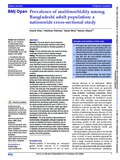| dc.contributor.author | Khan, Nusrat | |
| dc.contributor.author | Rahman, Mahfuzar | |
| dc.contributor.author | Mitra, Dipak | |
| dc.contributor.author | Afsana, Kaosar | |
| dc.date.accessioned | 2022-04-10T07:44:29Z | |
| dc.date.available | 2022-04-10T07:44:29Z | |
| dc.date.copyright | 2019 | |
| dc.date.issued | 2018-11-28 | |
| dc.identifier.citation | Khan, N., Rahman, M., Mitra, D., & Afsana, K. (2019). Prevalence of multimorbidity among Bangladeshi adult population: A nationwide cross-sectional study. BMJ Open, 9(11) doi:10.1136/bmjopen-2019-030886 | en_US |
| dc.identifier.uri | http://hdl.handle.net/10361/16529 | |
| dc.description | This article was published in BMJ Open [ © Author(s) (or their employer(s)) 2019. Re-use permitted under CC BY-NC. No commercial re-use. See rights and permissions. Published by BMJ.] and the definite version is available at: http://dx.doi.org/10.1136/bmjopen-2019-030886. The Journal's website is at: https://bmjopen.bmj.com/content/9/11/e030886 | en_US |
| dc.description.abstract | Objective This study aimed to report prevalence and evaluate the association between multimorbidity and associated risk factors in the adult population of Bangladesh.
Design A cross-sectional study was conducted using a multistage clustered random sampling strategy.
Setting The study was conducted among the general population of 58 districts in Bangladesh.
Participants A total of 12 338 male and female individuals aged ≥35 were included for analysis in this study. Identified through a household listing conducted prior to the study, from 15 297 individuals meeting the inclusion criteria, 12 338 participants were included based on availability during data collection, consent and health condition.
Outcome measures Multimorbidity in terms of hypertension, diabetes, cancer, cardiovascular diseases, stroke and chronic obstructive pulmonary disease.
Results Approximately 8.4% (95% CI 7.0 to 9.7) of individuals suffer from multimorbidity, of which hypertension accounted for (30.1%) followed by diabetes (10.6%). The mean age of the population was 58.6 (SD ±9.2) years. The prevalence of multimorbidity was lower among men (7.7%) compared with women (8.9%). The likelihood of having multimorbidity among obese individuals were more than double than people with normal body mass index (BMI). Physical activity protected individuals from developing multimorbidity: however, the physical activity adjusted OR was 0.5 (95% CI 0.2 to 1.2). After adjusting for all covariates, higher age, higher educational status, economic status, and higher BMI were found to be significantly associated with the odds of developing multimorbidity, with an overall adjusted OR of 0.02 (95% CI 0.01 to 0.02).
Conclusion This study reported a high prevalence of multimorbidity in Bangladesh, although it explored the burden and identified risk factors considering only six chronic diseases. Further detailed exploration through longitudinal studies considering a wider range of diseases is needed to document the actual burden, develop effective preventive measures and clinical guidelines to improve the quality of life of the population. | en_US |
| dc.language.iso | en_US | en_US |
| dc.publisher | BMJ Journals | en_US |
| dc.relation.uri | https://bmjopen.bmj.com/content/9/11/e030886 | |
| dc.subject | Global health | en_US |
| dc.subject | Multimorbidity | en_US |
| dc.subject | Non-communicable disease (NCDS) | en_US |
| dc.subject | Risk factors | en_US |
| dc.title | Prevalence of multimorbidity among Bangladeshi adult population: A nationwide cross-sectional study | en_US |
| dc.type | Journal Article | en_US |
| dc.description.version | Published | |
| dc.contributor.department | Brac James P. Grant School of Public Health | |
| dc.identifier.doi | http://dx.doi.org/10.1136/bmjopen-2019-030886 | |
| dc.relation.journal | BMJ Open | |

